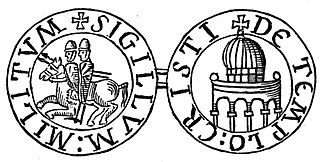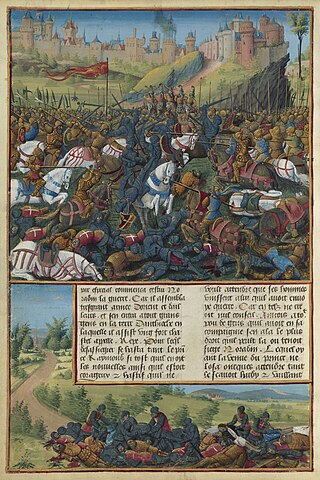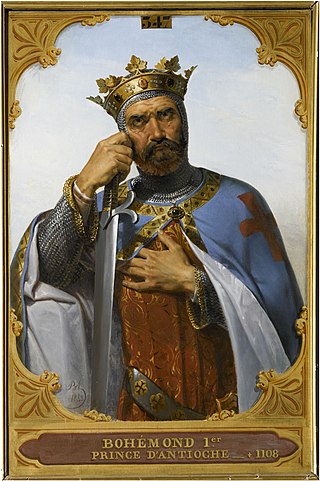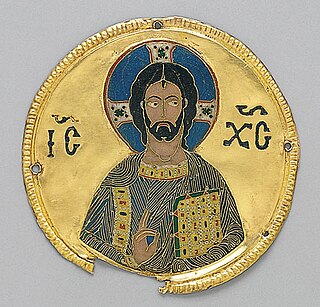Related Research Articles

Bernard of Clairvaux, O. Cist., venerated as Saint Bernard, was an abbot, mystic, co-founder of the Knights Templar, and a major leader in the reformation of the Benedictine Order through the nascent Cistercian Order.

The Poor Fellow-Soldiers of Christ and of the Temple of Solomon, mainly known as the Knights Templar, was a French military order of the Catholic faith, and one of the wealthiest and most popular military orders in Western Christianity. They were founded c. 1119, headquartered on the Temple Mount in Jerusalem, to defend pilgrims on their way to the Holy City and existed for nearly two centuries during the Middle Ages.

Pope Alexander III, born Roland, was head of the Catholic Church and ruler of the Papal States from 7 September 1159 until his death in 1181.

Pope Eugene III, born Bernardo Pignatelli, or possibly Paganelli, called Bernardo da Pisa, was head of the Catholic Church and ruler of the Papal States from 15 February 1145 to his death in 1153. He was the first Cistercian to become pope. In response to the fall of Edessa to the Muslims in 1144, Eugene proclaimed the Second Crusade. The crusade failed to recapture Edessa, which was the first of many failures by the Christians in the crusades to recapture lands won in the First Crusade. He was beatified in 1872 by Pope Pius IX.

The Second Crusade (1147–1150) was the second major crusade launched from Europe. The Second Crusade was started in response to the fall of the County of Edessa in 1144 to the forces of Zengi. The county had been founded during the First Crusade (1096–1099) by King Baldwin I of Jerusalem in 1098. While it was the first Crusader state to be founded, it was also the first to fall.

Bohemond I of Antioch, also known as Bohemond of Taranto or Bohemond of Hauteville, was the prince of Taranto from 1089 to 1111 and the prince of Antioch from 1098 to 1111. He was a leader of the First Crusade, leading a contingent of Normans on the quest eastward. Knowledgeable about the Byzantine Empire through earlier campaigns with his father, he was the most experienced military leader of the crusade.

Pons was count of Tripoli from 1112 to 1137. He was a minor when his father, Bertrand, died in 1112. He swore fealty to the Byzantine Emperor Alexios I Komnenos in the presence of a Byzantine embassy. His advisors sent him to Antioch to be educated in the court of Tancred of Antioch, ending the hostilities between the two crusader states. Tancred granted four important fortresses to Pons in the Principality of Antioch. Since Pons held his inherited lands in fief of the kings of Jerusalem, Tancred's grant strengthened the autonomy of the County of Tripoli. On his deathbed, Tancred also arranged the marriage of his wife, Cecile of France, to Pons.
William X, called the Saint, was Duke of Aquitaine, Duke of Gascony, and Count of Poitou from 1126 to 1137.

The Wendish Crusade was a military campaign in 1147, one of the Northern Crusades, led primarily by the Kingdom of Germany within the Holy Roman Empire and directed against the Polabian Slavs. The Wends were made up of the Slavic tribes of Abrotrites, Rani, Liutizians, Wagarians, and Pomeranians who lived east of the River Elbe in present-day northeast Germany and Poland.

The Rhineland massacres, also known as the German Crusade of 1096 or Gzerot Tatnó, were a series of mass murders of Jews perpetrated by mobs of French and German Christians of the People's Crusade in the year 1096, or 4856 according to the Hebrew calendar. These massacres are often seen as the first in a sequence of antisemitic events in Europe which culminated in the Holocaust.

Hugh was a French noble who was the first Count of Champagne. He was known for donating the valley that was used as the site for the Clairvaux Abbey and going on several pilgrimages to the Holy Land. During his second visit, Hugh de Paynes, a knight in his service, stayed in Jerusalem and established the Knights Templar. Hugh later gave up his wealth and lands to join the Templar Order.

Everard des Barres was the third Grand Master of the Knights Templar from 1147 to 1152.
Quantum praedecessores is a papal bull issued on 1 December 1145 by Pope Eugenius III, calling for a Second Crusade. It was the first papal bull issued with a crusade as its subject.
Zoé Oldenbourg was a Russian-born French popular historian and novelist who specialized in medieval French history, in particular the Crusades and Cathars.
Alberic of Ostia (1080–1148) was a Benedictine monk, diplomat and Cardinal Bishop of Ostia from 1138 to 1148. He was one of the most important people in the administration of Pope Eugenius III, especially due to his diplomatic skills.
Henry of Marcy, or Henry de Marsiac, was a Cistercian abbot, first of Hautecombe in Savoy (1160–1177), and then of Clairvaux, from 1177 until 1179. He was created Cardinal Bishop of Albano by Pope Alexander III at the Third Lateran Council in 1179.

Christianity in the 12th century was marked by scholastic development and monastic reforms in the western church and a continuation of the Crusades, namely with the Second Crusade in the Holy Land.
Gérarddu Cher, numbered Gerald II, was the bishop of Limoges from 1142 until his death. Born into the lower nobility, he succeeded his uncle, Eustorge de Scorailles, as bishop. Five years elapsed between Eustorge's death in 1137 and Gérard's election. He was selected by the cathedral chapter in an election free of outside interference.

The timeline of the Principality of Antioch is a chronological list of events of the history of the Principality of Antioch.

On 31 March, 1146, the French abbot Bernard of Clairvaux preached at Vézelay to encourage support for the Second Crusade.
References
- 1 2 Bredero 1996, p. 284.
- ↑ Bredero 1996, p. 283.
- ↑ Lilie 1993, p. 155.